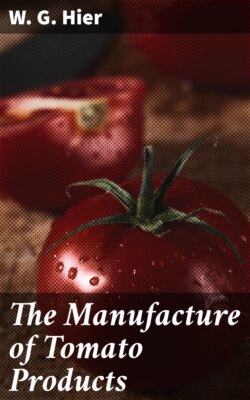The Manufacture of Tomato Products

Реклама. ООО «ЛитРес», ИНН: 7719571260.
Оглавление
W. G. Hier. The Manufacture of Tomato Products
The Manufacture of Tomato Products
Table of Contents
Preface
PART I. The Manufacture of Whole Tomato Pulp or Puree
CHAPTER I. OBTAINING GOOD TOMATO STOCK
Value of Good Tomato Stock
Plant Raising
Use of Fertilizer
Methods in East and West
Shipping Tomatoes
Tomato Crates
Degrees of Ripeness for Shipping
Careful Handling at Factory
Varieties
Storing Tomatoes
Stemless Tomatoes
CHAPTER II. WASHING AND SORTING
Washing and Sorting Equipment
Rotary Washer
Water Bath With Compressed Air
Importance of Agitation
Plain Sorting Belt
Number of Sorters
Tomato Turning Device
Divided Sorting Belt
Sorting
Forms of Decay
Cleanliness of Equipment
Molds, Yeasts and Spores, and Bacteria
CHAPTER III. PRINCIPAL METHODS IN USE FOR PULPING
Cold Pulping
Care of Cyclone
Hot Pulping
Advantages Claimed for Hot Pulping
Objections to Hot Process
Crushing
Conveying to Kettle
Value of Pumice
CHAPTER IV. CONDENSING THE STRAINED OR CRUSHED TOMATOES
Vacuum Pan
Types of Open Kettles
Steam Pressure
Copper-Jacketed Kettles
Tinning Kettles
Advantages of Various Types of Kettles
Glass-Lined Tank
Cypress Tank
Cleaning Kettles
Coil Leaks
Starting the Cooking
Methods of Gauging Finishing Point
Cooking to a Gauge on Kettle
Cooking a Definite Length of Time
Determining Specific Gravity by Weight
Objections to Weighing Method
Testing With Hydrometer
Method of Using Hydrometer
Finishing the Cooking
CHAPTER V. CONVEYING THE CONDENSED, STRAINED, OR CRUSHED TOMATOES TO THE FINISHING MACHINE AND FINISHING SAME
Conveying to Finisher
Receiving Tanks
Finishing
Screen Metal for Finisher
Effect of Finishing on Mold Count
Finishing Before Cooking
CHAPTER VI. FILLING THE FINISHED PULP AND STORING THE CANNED PRODUCT
Filling Devices for Five Gallons
Square Can and Round Can
Testing for Leaks
Washing and Steaming
Filling and Capping
Handling Filled Cans
Advantages of Separating Batches
How to Stack
Processing
Life of Cans
Washing and Drying Cans
Protection From Dust
Testing Used Cans
Packing 10’s and 1’s
Packing Barrel Pulp
Metal Drums
A Method of Preserving Pulp in Barrels
CHAPTER VII. THE MICRO-ORGANISMS OF TOMATO PRODUCTS; THE ATTITUDE OF THE PURE FOOD AUTHORITIES TOWARD THEM; AND THE INTERPRETATION OF ANALYSES
Micro-Organisms; What They Are
Molds
Bacteria
Yeasts
Spores
How Germs Retard Their Own Growth
Rapidity of Growth
The Government Attitude on Micro-Organisms
Government Regulations
State Food Officials
Checking Up Daily Runs
How to Interpret Analyses
PART II. The Manufacture of Tomato Catsup, Chili Sauce, Trimming Pulp, and Tomato Soup
CHAPTER VIII. A DISCUSSION OF PRESERVATIVE AND NON-PRESERVATIVE CATSUPS, AND THE MOST FREQUENT CAUSES OF INFERIORITY
Unfavorable Publicity on Preservatives
“Natural” Preservatives
Proper Acidity
Processing Catsups
Advantage of Benzoate Catsups
Causes of Poor Color and Flavor
Advantage of Direct Conversion of Tomatoes Into Catsup
Thickness
Spicing and Sweetness
“Black Neck”
General Attractiveness
CHAPTER IX. A DISCUSSION OF THE INGREDIENTS OF CATSUP; WHEN AND HOW THEY SHOULD BE ADDED; AND THE AMOUNTS OF EACH PER 100 GALLONS OF FINISHED CATSUP
Measuring the Volume of Tomato Juice
Amount of Tomatoes
Keeping Batches Uniform
Use of Spices in a Sack
Use of Spices Direct and When to Add Them
Use of Spices in Two Batches
What Is Extracted
Storing Spices
Quality of Flavor
Use of Essential Oils
How to Add Essential Oils
Paprika
Quantities of Spices and Oils per Batch
Essential Oils Economical
Adulteration of Ground Spices
Onions and Garlic
Sugars
Sugar Syrups
Use of Sugar in Large Quantities
Salt
Vinegar
Transference of Vinegar
Adding the Vinegar
Acidity
Testing the Finishing Point
Holding Batches
Making Catsup From Pulp
Use of Benzoate of Soda
CHAPTER X. FINISHING, BOTTLING, STERILIZING, AND STORING THE CATSUP
The Receiving Tank and Finisher
Filling and Sealing
Washing the Filled Bottles
Processing
Advantages of Omitting Processing
Process Method
Time and Temperature
Temperature Controlling and Recording Devices
Non-Process Method
Which Method Is the Better?
Labeling and Casing
Stacking Catsup to Avoid “Black Neck”
Packing Gallons and No. 10’s
CHAPTER XI. THE MANUFACTURE OF CHILI SAUCE AND THE PULPING OF TOMATO TRIMMINGS
Grading the Tomatoes
Method of Handling Tomatoes
Amount of Tomatoes and Onions
Spices
Salt, Sugar and Vinegar
Testing Finishing Point
Filling, Sealing, and Sterilizing
Microscopical Counts
Pulping the Trimmings
Government Attitude on Trimming Pulp
Method of Handling Tomatoes When Trimmings Are Pulped
CHAPTER XII. THE MANUFACTURE OF TOMATO SOUP
Convenience and Economy of Canned Soup
Factors Upon Which Success Depends
Unpalatability
Proper Sweetness
Gradual Souring of Pulp
Sampling
Proper Acidity
Price and Quality
Microscopical Counts
Beginning the Cook and Adding Soda
Butter, Spices and Onions
Sugar and Salt
Testing Thickness Before Adding Flour
Adding Flour
Filling and Processing
Shaking and Labeling
Отрывок из книги
W. G. Hier
Including whole tomato pulp or puree, tomato catsup, chili sauce, tomato soup, trimming pulp
.....
By having the tomatoes thoroughly clean, with no mud and scarcely any mold adhering to the surface when they drop on the sorting belt, the amount of sorting required is not only greatly lessened, but the spots of black rot and other forms of decay show up prominently on the surface.
It is important that the reel deliver the tomatoes to the sorting belt at a uniform rate, which is seldom done when the crates are dumped into the reel without any system of timing them. At present a hopper for feeding the reel is being experimented with, and it is hoped that it will be an improvement over the uncontrolled system that is now used.
.....